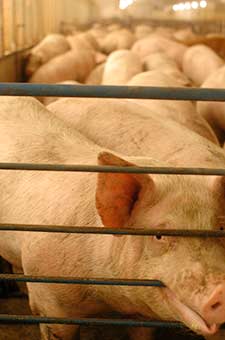He looked down at the tangled wet hair, the wild, bare, animal shoulders. He was amazed, bewildered, and afraid. He had never thought of loving her. He had never wanted to love her. When he rescued her and restored her, he was a doctor, and she was a patient. He had had no single personal thought of her. Nay, this introduction of the personal element was very distasteful to him, a violation of his professional honour. It was horrible to have her there embracing his knees. It was horrible. He revolted from it, violently. And yet – and yet – he had not the power to break away. —excerpt from the The Horse Dealer’s Daughter-D.H. Lawrence
Editorial
The great modern scientific achievements of the 20th century that brought us life saving antibiotics, synthetic fertilizers, vitamin supplements, and insect controlling pesticides provided an essential arsenal of tools to seemingly divorce ourselves from nature, and allowed us to usher in the great industrial agriculture revolution. By the later half of the century, for the first time in human history, agriculture production could be assembled on a giant, and centralized scale; massive tracts of land could be used to grow a single crop at a time, and large numbers of livestock could be housed in warehouse style buildings without ever having to see the light of day (thanks to vitamin D, and antibiotics). Models based upon achieving hyper-efficiencies, and through economies of scale— fueled a ceaseless march toward ever cheaper cost per units of agriculture production. With each passing decade, the changing face of American agriculture became larger, more industrial, operating more like a factory, than a living (and breathing) small farm.

In the past, the tyranny of farming, so highly dependent upon the vast and uncontrollable forces of nature finally began to give way to man’s modern scientific prowess, and nowhere more given to sway than in the production of livestock.
For farm animals, in particular: chickens, hogs, cattle, and dairy cows may now be housed in massive numbers, so tightly confined, in many cases, unable to move around and never to touch a blade of grass, roll in any mud, or permitted outside. The government has a name for these massive corporate owned megafarms, they have been designated as concentrated animal feeding operations (CAFO’s), but to a growing cadre of critics, they see them simply as a form of livestock concentration camp. And their supposed models of efficiency, and economies of scale not only ignore the steep environmental and social costs, they subject animals to such cruelty, and needless suffering: their very existence can only represent a demarcation line between good and evil.
As Dan Imhoff explains in part 1 of this video— editor of the new (coffee table size) book CAFO, a large body of illuminating essays, and full spread pages of (full-throttled) images depicting a litany of inhumane livestock conditions and their effects—the toll of these CAFO operations upon local communities, public health, and the environment obliterates any supposed economic advantages of such a system. Only through large federal subsidies (in the Farm Bill), and by ignoring a range of hidden (or largely obscured) costs that are ultimately borne by the taxpayer and eater, can their existence be cost justified.
Who we are as a people is defined by what we do, and what we think is right. Those of us who look back upon recent history, and wonder how so many genocides were allowed to happen by so many (presumably good) people; we all carry within us the seeds of our own destruction. That may be sober reason enough to not allow these megafarms to continue in our name.
Filmed November 9, 2010 at the Friends of Family Farmers InFARMation (and Beer!) event.
Most of the videos featured on Cooking Up a Story were produced, filmed, and edited by Rebecca Gerendasy. Fred Gerendasy contributed as a writer to many of the posts and occasionally as the interviewer. Visit Rebecca Gerendasy Clay – Art and Fred Gerendasy Photography to see their current work.

